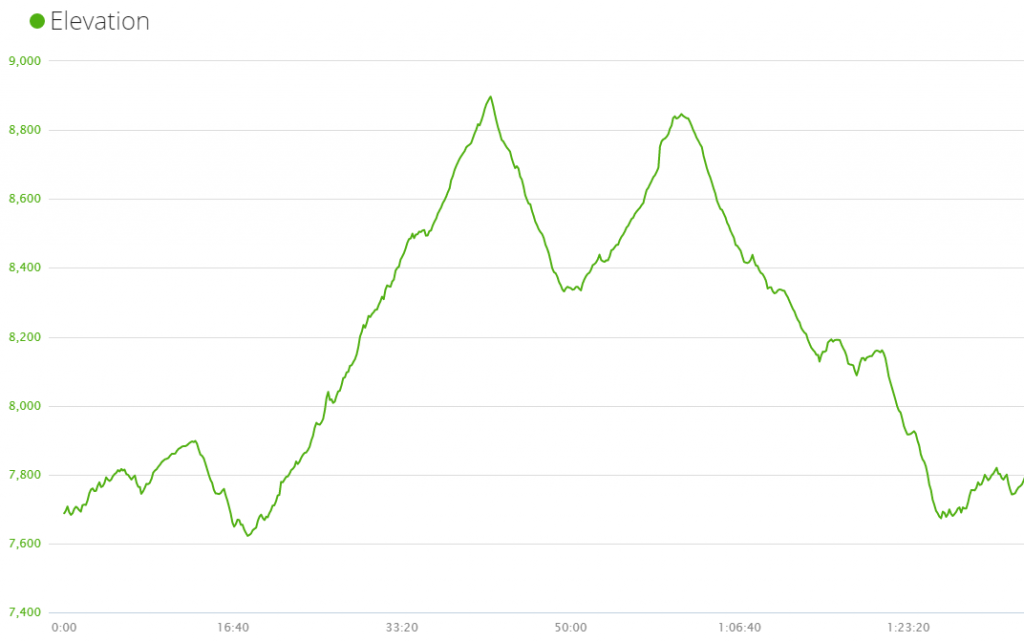This year I’m challenging you to Get Out of Your Comfort Zone. To do things differently. To remember that “what got you here, won’t get you there.”
Remember, as Coach Jay Johnson once said:
To do something you’ve never done before, you have to do something you’ve never done before.

To get to the next level – whether that’s reaching a new race distance, running faster than ever, or finally losing those last 5 pounds – requires a new, fresh approach.
It’s not as simple as “trying harder” or “buckling down” to do the same things you’ve always done:
- If that weight loss program hasn’t worked the last 6 times, why will it work this month?
- If you keep getting injured, what are you doing differently this training cycle to finally stay healthy?
- If you can never stick to eating great food, will this year’s New Year Resolution actually stick?
If you don’t get out of your comfort zone and try something new, you will likely fail again… and again.
And I know from brutal experience. I can’t count how many times my plans have failed, all because I had no system in place to help me succeed.
In college, I tried to increase my mileage to 90 mpw countless times – I got hurt after every. single. attempt. As soon as I wrote “90” in my training log, a new injury would surface. It was eerily predictable.
That failure was on my shoulders, not my coaches. I was doing too much without asking for help (getting help is NOT a sign of weakness, as I now know).
I’ve shared the intimate details of my battle with chronic injuries and how I overcame them. My injury prevention system has since helped about a thousand runners (!).
Since then, I’ve run over 90 miles several times with no injury problems – all because there was a plan in place to virtually guarantee my success. I did things differently and reaped the rewards, getting in the best shape of my life.
I want YOU to experience that same success. Soon I’ll be focusing on one of the most powerful systems that’s helped me (and thousands more) bring their running to new heights.
First, let’s look at my last training cycle – when I felt like the Incredible Hulk.
Quietly Putting in the Big Boy Miles…
Two months ago, a week before Thanksgiving, I increased my weekly mileage by 40%. Within two weeks, I was running almost double what I had been for the previous three months.
Not only was my mileage higher than it had been since before the Boston Marathon, I felt incredible. My energy levels were through the roof and recovery was at an all-time high. I was barely sore – even after hammering thousands of feet of downhill running in the Rockies.
I felt like I was firing on all cylinders. Every weekend I ran my long run in the mountains, often with 3-4,000 feet of elevation gain like this:

Not only was my mileage high, a lot of it was on technical terrain at an altitude approaching 9,000 feet. My pace was surprisingly fast, even for a long run in this environment.
The funny part? I’m not even training for a race!
This type of training was the result of combining multiple systems: my injury prevention principles with an all-new nutrition program.
Can you imagine what it feels like to complete runs like this – within a PR mileage week – and still have sky-high energy levels?
This new system allowed me to:
- Tie my record weekly mileage level of 91, but now without feeling tired or worn down
- Have unbelievably high energy throughout the day to play with my daughter, work like mad on Strength Running, and still have fun
- Be fueled properly for my longest run ever: over two and half hours (at altitude)
With higher energy levels, I was able to get up early (I’m NOT a morning person) to run in the mountains and experience stunning scenes like this:
A photo posted by Jason Fitzgerald (@jasonfitz1) on
Accomplishing the training workload from last fall required a lot of changes to how I recovered, trained, and ate. Those changes weren’t easy.
In fact, I jokingly tell my wife Meaghan all the time that “I fear change.” It’s partly true – for all of us. Change is hard, but it’s necessary for growth.
I needed to step WAY outside of my comfort zone to run high mileage like this in the mountains. And it was worth every sacrifice.
Confession: My Nutrition Sucks
I’ve always said that my diet “isn’t perfect.” Truthfully, sometimes my nutrition is horrendous and I’ve been self-conscious about revealing that.
That feeling when… you open a mini package of Starbursts and the two colors are pink and red. #winning — Jason Fitzgerald (@JasonFitz1) November 7, 2014
But it’s time that I spilled the beans:
- I’ll eat an entire sleeve of Oreos without a second thought
- Sometimes I only eat vegetables when my wife makes me at dinner…
- I have a secret love of fast food (OMG give me a double Whopper with cheese and a large fry!)
This is not how a runner should eat. Especially one like me, with big running goals and who wants to set a good example for his daughter.
But last fall, I vowed to finally get it right – to figure out the best way to fuel before a grueling long run, exactly what to eat after a tough workout to spike recovery, and how to dramatically increase my energy levels.
And it worked: I was running a LOT and feeling better than ever. These nutrition strategies were responsible for an amazing month of training.
And now that the holidays are over, I’m getting back to feeling like the Incredible Hulk.
I had help, of course. I’m not a nutritionist and I’m not qualified to speak about diet too in-depth.
Over the last six months, I’ve been collaborating with Anne Mauney to figure out the specifics of fueling, eating for performance and health, and how runners can reach their goal weight.
It wasn’t easy. Because I’m naturally thin, I can eat practically whatever I want with no worry of gaining weight. So, why should I worry about nutrition? Is tweaking my diet for optimum performance and recovery really that helpful?
Yes, it was incredible! I’ve never felt so energized and invincible. But working on my diet required me to get WAY outside my comfort zone.
Learning from Anne’s experience as a registered dietitian and her extensive client work has been truly illuminating.
And soon, I want to bring all of those lessons to you.
The Failure of the Last Mile
For nearly five years, I’ve been helping runners run faster, reach their goals, and stay healthy. And I consider myself damn good at my job with results like this.
But there’s an interesting trend I’ve noticed among most runners: the failure of the last mile.
It comes in many forms:
- Meticulously following a marathon training plan, but failing to fuel properly for the race itself
- Buying a new GPS watch, fancy shoes, and a handheld water bottle but failing to train consistently
- Planning a detailed training program, completing every workout, but not having a pacing strategy for the goal race
It’s focusing on the big picture (which is good) but then failing to execute the final step.
Achieving success requires you to NOT fail the last mile. You have to seal the deal.
The final details are what separates the successful from the unsuccessful.
But often, the final mile is the most difficult. It’s what requires you to dig deep and truly get outside your comfort zone.
For most of us, we focus on our training but fail when it comes to our nutrition.
And let’s be honest: WE ARE ATHLETES.
We can’t fail at our nutrition because it’s what supports our health, recovery, training and performances.
Runners can’t fail at nutrition – it’s what helps us run fast!
Our diet is directly responsible for our success. If we are what we eat, then we must fuel appropriately.
Nutrition has the power to transform our running performances – but also our day to day lives: more energy to work hard and play with our kids. Better focus and a heightened sense of well-being.
For the next few weeks, we’ll be focusing on this specific area. Are you ready to get out of your comfort zone?
My Final Question for You:
If you’re ready to get out of your comfort zone, achieve your goal weight, fuel right for peak energy, and eat the most nutritious diet possible, then you’re in the right place.
These topics will challenge us – and force us to confront our bad habits – but they’re critical for helping us achieve our running goals.
If this sounds good to you, I can’t wait to go on this journey with you.
As we progress through the Year of Getting Out of Our Comfort Zones, what problems do you have with nutrition?
I won’t judge (I’m the guy who can eat an entire pizza…).
If you tell me you struggle with gorging on fast food after long runs, that’s great! I’m excited to show you strategies that can help you overcome this struggle.
Think about these two questions:
- What is your #1 struggle with nutrition as a runner?
- How would achieving an ideal diet help your running?
As you think about what you’re struggling with and how an ideal diet could help your running, I have a small request:
Join our free nutrition series here and we’ll send you audio Q&A’s, diet lessons from a Registered Dietitian, and the top nutrition “myths” that are holding you back.